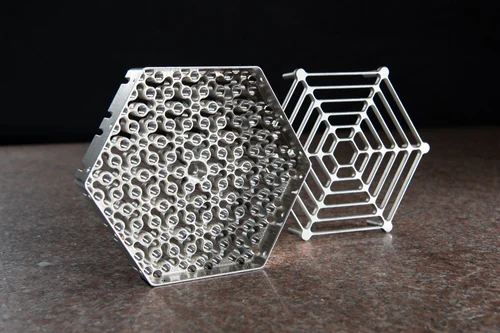According to the “Additive Manufacturing in the Energy Sector: Market Analysis & Forecast” report from Additive Manufacturing Research (AMR), the energy sector saw $2.6 billion worth of 3D printing activity in 2023 and is on track to generate $17 billion in additive manufacturing (AM) revenues by 2032. Despite the complex safety and regulatory issues associated with it, the nuclear sector is poised to benefit significantly from this traction, thanks to the role that 3D printing can play in producing more efficient parts more quickly and typically at a lower cost.
Among those leading the application of AM to nuclear power parts is Westinghouse Electric Company, which recently announced the completion of its 1,000th fuel flow plate manufactured using 3D printing techniques. This event not only marks a significant milestone for Westinghouse but also represents the first time safety-related AM components have entered serial production in the industry.

A fuel assembly component produced through additive manufacturing.
The recently manufactured AM flow plates are designed for installation in VVER-440 fuel assemblies. This adaptation has allowed for a redesign of the bottom part of the assemblies, enhancing their overall performance and robustness. This development is particularly noteworthy as it illustrates the shift of AM from mere prototyping or test components to full-scale, functional production.
Lou Martínez Sancho, the Chief Technology Officer and Executive Vice President of R&D and Innovation at Westinghouse, emphasized the importance of this achievement. He stated, “This achievement showcases the development of additive manufacturing from prototyping to full-scale production, generating tangible value for our customers.” He further highlighted that this milestone underpins Westinghouse’s commitment to advancing safety, efficiency, sustainability, and energy security through pioneering achievements in AM technology.

A 3D printed thimble plugging device made by Westinghouse.
The component is part of Westinghouse’s broader strategy to integrate AM into the nuclear industry to streamline costs, reduce lead times, and enable innovative solutions for energy generation. This journey began in 2015 when the company conducted the first material irradiation study of AM nuclear components, demonstrating its long-term commitment to AM technologies. In 2020, Westinghouse installed the first ever safety-related AM component, a Thimble Plugging Device, into an operating commercial reactor, setting a precedent for the future of nuclear manufacturing.
The fact that Westinghouse has been able to accomplish this feat is particularly important given how the larger corporation has struggled in the past decade. After being acquired by Toshiba in 2013, the company went on to face bankruptcy in 2017 until it was rescued by alternative investment management company Brookfield Corporation the following year. As of 2023, it was part owned by Brookfield and Cameco, the world’s largest publicly traded uranium company. In other words, though based in Pennsylvania, the $4.2 billion Westinghouse is owned by Canadian business interests.
Despite historical concerns with the environmental safety of nuclear power, it stands to be one of the more viable options for the global energy transition. However, the cost and time required to build power plants is extremely high, necessitating methods for alleviating these issues wherever possible. For this reason, AM is a particularly attractive method for producing key parts wherever possible.
On top of traditional methods for generating nuclear power, there has been more recently progress in more novel techniques including modular reactors, new types of nuclear fuel, and, of course, nuclear fusion. All of these newer developments are receiving increased attention and funding that likely warrant the use of 3D printing at some stage.
However, it’s particularly heartening to see a legacy firm like Westinghouse pioneer the use of AM in nuclear power immediately, rather than with a less fully realized technology some time in the future. As the company achieves such milestone as the serial 3D printing of a fuel flow plate for its technology, we can assume that designers of modular nuclear reactors may take a cue from Westinghouse and explore AM for similar parts in their own systems. In fact, because Westinghouse itself is developing microreactors, such cross-pollination is probably happening already.
Images courtesy of Westinghouse.
Subscribe to Our Email Newsletter
Stay up-to-date on all the latest news from the 3D printing industry and receive information and offers from third party vendors.
You May Also Like
Further Understanding of 3D Printing Design at ADDITIV Design World
ADDITIV is back once again! This time, the virtual platform for additive manufacturing will be holding the first-ever edition of ADDITIV Design World on May 23rd from 9:00 AM –...
3D Printer Maker EVO-tech Reborn as NEVO3D — Once More With Feeling
EVO-tech was a 3D printing service and original equipment manufacturer established in 2013 and based in Schörfling am Attersee, Austria. The company produced high-quality material extrusion systems featuring linear bearings,...
3D Systems Brings 3D Printed PEEK Cranial Implant to the U.S. with FDA Clearance
For more than 10 years, 3D Systems (NYSE:DDD) has worked hand-in-hand with surgeons to plan over 150,000 patient-specific cases, and develop more than two million instruments and implants from its...
CDFAM Returns to Berlin for Second Annual Symposium
The second CDFAM Computational Design Symposium is scheduled for May 7-8, 2024, in Berlin, and will convene leading experts in computational design across all scales. Building upon the first event...































